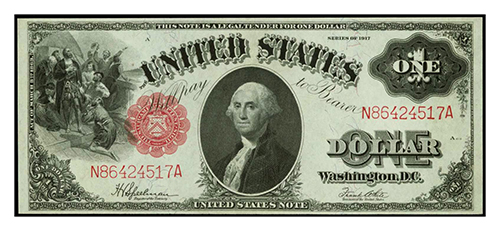1917 $1 Washington Saw Horse Note

Issuance for the 1917 $1 Washington Saw Horse note lasted from 1917 to 1923, when a final change was added after which the government decided to transition to smaller notes. This is the last example of American currency that displays a design which is asymmetrical, and it also features dual vignettes along with scroll work which is quite intricate.
History And Design Characteristics
This bill features a red colored seal along with a serial number which designates it as being of legal tender at the time of issue. However, it did not have silver backing, and the front side depicts an oval image of President George Washington with extra vignettes in the top left corner, one which shows Christopher Columbus setting foot in the New World. A sizeable rosette which is lathed can be seen in the top right side, which shows the bill’s denomination, along with a large oval in the lower side on the right which says ONE DOLLAR.
The back side of the bill displays a border which is large and exceptionally ornate, which shows the denomination in every corner, as well as a big feature which is X shaped in the middle which says “United States of America.” This is the shape which led to the nickname given to the bill, which is the Saw Horse.
Collection Notes
The year of issuance for this bill is 1917, though plans for its creation were initiated before. It is a one dollar bank note that is considered legal tender, but due to its age and collection value is worth far more than $1 today. Every one of these notes should display a red seal, yet there are five varieties in total, many of which are quite common. The most important aspect of this series is the signature of Burke Elliot, which can be seen to the left side.
As far as value is concerned, the general answer is that it depends on the condition of the bill, along with the age. Ninety nine percent of the 1917 $1 Washington Saw Horse notes have a value which ranges from $20 to as much as $150 each. However, a bill which was never circulated and which is in immaculate Gem condition can be valued at more than $200. Those interested in collecting these bills should always be on the lookout for those which have either star notes or serial numbers which are low. The reason for this is because these bills command a greater collection value.
When buying or selling these notes it is essential to remember that the type of seal, serial number, condition and signature are all extremely important. Most collectors will want you to provide photos and other information. The photos can be texted or sent by email over the web. Depending on the condition of the bill, you might be surprised at what some collectors are willing to pay.


